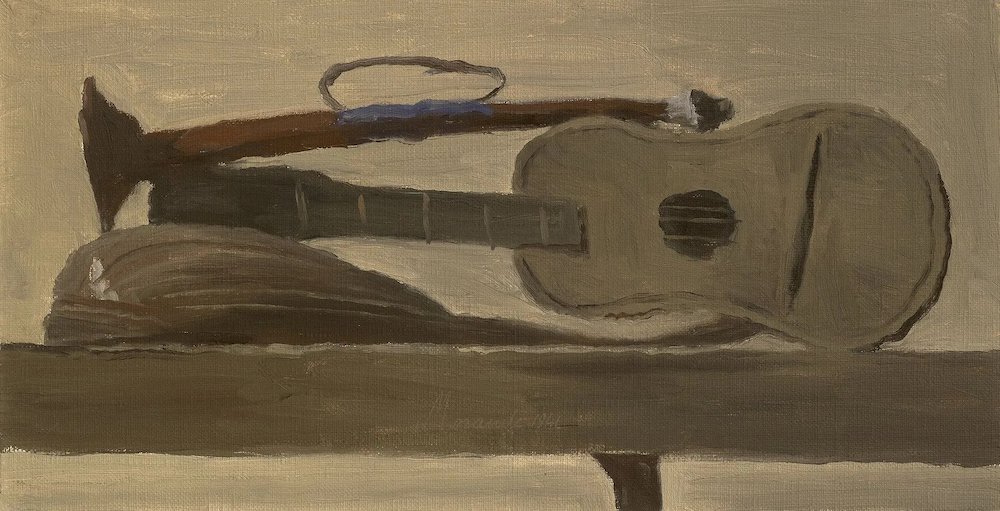Giorgio Morandi: Masterpieces from the Magnani-Rocca Foundation | Estorick Collection
This exhibition claims to show the only work Giorgio Morandi ever painted from a commission. Still Life (Musical Instruments), from 1941 and pictured below, is definitely a break from the norm for the artist, who was and remains famous for his oddly intense small paintings of collections of bottles and cups.
It isn’t surprising that this artist wasn’t receptive to commissions. Beyond his fame, Morandi stands out for the dogged narrowness of his focus, and his life. Living with his sisters and teaching at the university, working away in his small studio in Bologna (which I visited, once), painting, again and again, collections of modest household objects on an adjustable table.
Occasionally he went to the nearby town of Grizzana, and painted a view of his house. Sometimes he looked out of the studio’s window and painted the courtyard outside. Then he was straight back to his bottles. There are over 1,300 Morandis in the world, and pretty much all of them depict the subjects listed above.

This one-off collection of instruments, then, is a major departure from the norm. It was commissioned by Luigi Magnani, a rich patron who collected Morandi for decades and knew the artist well. The Estorick show represents a portion of his extensive collection of Morandis - mainly still lifes of bottles, of course.
Magnani seems to have overstepped the mark with this early 1940s commission, though. The patron sent the artist some instruments to paint. He was repaid for this impertinence by Morandi buying some junky instruments from the flea market, and dashing off a painting that’s both utterly characteristic of his style, and breathtakingly badly executed.
Characteristic, because with its horizontal format, and its thick beige-y palette, the painting is purely, distinctively Morandi. Bad, due to the obvious carelessness with which the instruments are put together.
Morandi’s monolithic bottles and cups sometimes seem to be floating in space, captured in some unearthly forcefield, trembling under the artist’s concentrated attention. By contrast, these junk shop instruments are instead carelessly dashed off, weightless, an afterthought.
“Only later did I understand the discomfort which the divergence from his habitual conception of painting had caused him,” Magnani later said of Morandi and the work. Which could be a polite way of conceding the painting’s badness, and blaming himself for it.
Viewing the painting certainly casts some of the painfully polite letters between the paints and the patron, collected elsewhere in the show, in a different light. Perhaps through gritted teeth, Morandi sticks to generalities. (“Many thanks for your kind wishes, which my sisters and I likewise warmly extend to your parents…”) Then he gets down to business, and very often explains how he’s tired, he’s busy, and he doesn’t have any paintings to offer.
The transactional nature of the relationship between artist and patron seems to have provoked a shared sense of awkwardness, but there’s no doubt who ultimately has the upper hand. “Rest assured that I will think about the painting you have asked for,” Morandi writes in 1950. Has Magnani attempted to slip him another brief? Maybe to have a second go at some fancier instruments?
Of course, if the 1941 still life is the only work Morandi painted to commission, that request ultimately went unfulfilled, and the artist went back to his divine bottles and cups. On this evidence, that’s no bad thing.
Giorgio Morandi: Masterpieces from the Magnani-Rocca Foundation is at the Estorick Collection (London). 06 January - 28 May 2023